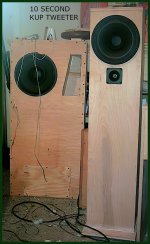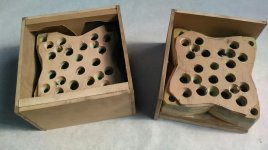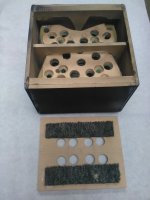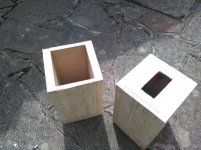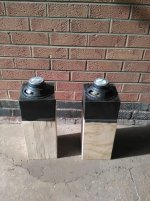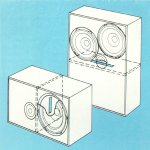I noticed that Amazon UK had some In Phase Car Audio XTC17.2 woven glass fibre coned drivers for £ 21.11p, so I decided to order them and make some omnidirectional speakers with them
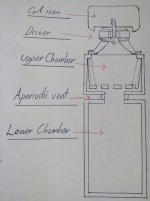
The driver is mounted on a small chamber that is connected to another, larger chamber by an aperiodic vent. My initial plan was to support the top chamber on coil springs with a foam seal, however the cast iron weights that became available ( the scrap bin at work ) are to heavy, and the temporary foam spacers that I used for initial testing work quite well

The driver is mounted on a small chamber that is connected to another, larger chamber by an aperiodic vent. My initial plan was to support the top chamber on coil springs with a foam seal, however the cast iron weights that became available ( the scrap bin at work ) are to heavy, and the temporary foam spacers that I used for initial testing work quite well
I tried a somewhat similar idea, which was basically a driver at the end of a tube, pointing up. The tube was floor-loaded and used a mass load port, which was basically a 12mm slot at opposite end. I used wood blocks to raise it above the carpet, by, say another 12mm... Bass response falling off at 80 or so, for a 3.5" driver.
I find Omni different sounding than OB. In Omni, everything's radiating in-phase about the speaker. In OB, the rear radiation is out of phase with the front. To get that, you have to give up the box and the bass extension that goes with it...in order to make use of the back of the cone for something different.
Even if you use two drivers back-to-back in dipole, you give up the ability to excite an enclosure at bass frequencies, because they're running out of phase. One thought experiment involves mating two pair of 3.5" MA drivers in this way - with the "front" driver on a baffle board...
Ever since exposure to OB soundstage, I find "something missing" with my speakers that dont have an out of phase radiation towards the rear wall. I found myself in an endless loop trying out schemes and I finally just surrendered. They're big, ugly but they give me the sound - unlike the graceful standing tubes that threw in-phase sound everywhere.
I find Omni different sounding than OB. In Omni, everything's radiating in-phase about the speaker. In OB, the rear radiation is out of phase with the front. To get that, you have to give up the box and the bass extension that goes with it...in order to make use of the back of the cone for something different.
Even if you use two drivers back-to-back in dipole, you give up the ability to excite an enclosure at bass frequencies, because they're running out of phase. One thought experiment involves mating two pair of 3.5" MA drivers in this way - with the "front" driver on a baffle board...
Ever since exposure to OB soundstage, I find "something missing" with my speakers that dont have an out of phase radiation towards the rear wall. I found myself in an endless loop trying out schemes and I finally just surrendered. They're big, ugly but they give me the sound - unlike the graceful standing tubes that threw in-phase sound everywhere.
I wonder how much frequency response is required to give the open baffle sound, I think Bose used rear firing cone tweeters that were crossed over at about 1,000 Hz, and I presume that they did research into it. What about a rear driver in phase at bass frequencies, but out of phase high up ? I have tried back to back drivers full range ( with a slight bias of high frequencies on the front driver ) with a rear firing dome tweeter ( just with a 1 uf cap ), the rear tweeter does seem to give an "ethereal " quality to the sound, as well as giving a little sparkle to treble.
- not "omni" but once as a helper tweeter I took a Gen1 Eminence APT50, a small coffee cup and scissors and had a fun helper tweeter which could be directed somewhat by rotating the styrofoam cup
(APT50 also appears fired upwards in a Klang & Ton project with an amni reflector)
does it take some rise in a driver's on-axis response to work well as an omni?
(APT50 also appears fired upwards in a Klang & Ton project with an amni reflector)
does it take some rise in a driver's on-axis response to work well as an omni?
Attachments
It's not optimum, but having listened to it I can't hear any ill effects. I might stick some felt or foam on the inside of the frame to reduce any reflections, and keep a lookout for a driver with a more open, cast frame. I'm also considering foam rings between the frame and cast iron weight, and between the gaps in the frame and the top chamber.
@cracked case
your aperiodic arrangement made me think of Brigg's "acoustic filter" (which helped in several ways including cone excursion)
https://i.imgur.com/MO4EHbX.jpg
your aperiodic arrangement made me think of Brigg's "acoustic filter" (which helped in several ways including cone excursion)
https://i.imgur.com/MO4EHbX.jpg
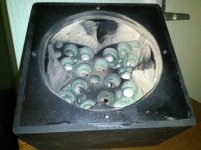
This is the inside of the inner top chamber, the lobed petal shape is to diffuse internal sound waves.
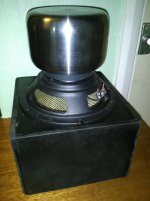
This is a trial assembly of the cast iron weight, held in place with an M4 bolt passing through the driver. I don't advocate fine metric threads in cast iron, however is the thread strips I can always drill and tap it out 5/16 whit and use an insert. There is an MDF disc between the magnet and weight.
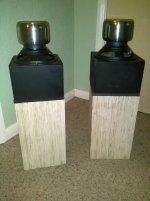
These are the parts stacked together.
I actually got the idea of the double chamber from Hi Fi world magazine in their articles on the WD25T speaker, and got the box volumes from a comment on diyaudio.@cracked case
your aperiodic arrangement made me think of Brigg's "acoustic filter" (which helped in several ways including cone excursion)
https://i.imgur.com/MO4EHbX.jpg
It's not optimum, but having listened to it I can't hear any ill effects.
Which is all that matters.
And they look very good. Pleasingly different design from the run of the mill too.
Here's a link to a pdf of that article. https://www.google.com/url?sa=t&rct...d=1412494604&usg=AOvVaw0VlKZu5wkrmyhdhB4km4oNI actually got the idea of the double chamber from Hi Fi world magazine in their articles on the WD25T speaker...
Dynaco, of course, were the originators of the double chamber acoustic resistance enclosure.
Attachments
your aperiodic arrangement made me think of Brigg's "acoustic filter" (which helped in several ways including cone excursion) https://i.imgur.com/MO4EHbX.jpg
I'd just like to make it clear, freddi, that the "acoustic filter" in the plywood column to which you link does not constitute an aperiodic arrangement.
The plywood column is a bass reflex enclosure, having twin ports located near the base of the column.
The narrow slits in the acoustic filter allow only the bass frequencies to pass unhindered into the lower compartment and, consequently, the emission of sound through the ports at medium and high frequencies is reduced.
As you say, the acoustic filter reduces low frequency cone excursions, but with the advantage of increasing the power handling capacity.
The main advantage of an acoustic filter in a column speaker is that the dip in response due to the vertical standing wave is avoided.
>The narrow slits in the acoustic filter allow only the bass frequencies to pass unhindered into the lower compartment.
So it's almost like a "laminar flow element", adding resistance to the air motion. Seems like a pretty useful construct in speaker building.
Like, what would happen if you put such a thing at both ends of an H frame? Would you be able to effectively kill the cavity resonance, while adding resistance for higher power handling?
A couple wood panels with a bunch of holes or slots in it, versus a DSP lowpass with a steep slope, or analog notch filter.
So it's almost like a "laminar flow element", adding resistance to the air motion. Seems like a pretty useful construct in speaker building.
Like, what would happen if you put such a thing at both ends of an H frame? Would you be able to effectively kill the cavity resonance, while adding resistance for higher power handling?
A couple wood panels with a bunch of holes or slots in it, versus a DSP lowpass with a steep slope, or analog notch filter.
Note that the slits in Briggs' acoustic filter are the width of a saw blade.A couple wood panels with a bunch of holes or slots in it...
I love the 'Robbie the Robot' look with the shiny bits on top!
All the 'legs' need is a little putty if they are ringing at higher levels(they are probably not).
Diffraction is the primary effect re: the legs.
Sheet metal legs(baskets) are used in some of my Ohm Walsh speakers- not a problem.
If you can eq with a contour filter(or otherwise), and do not need a tweeter for the top octave or two, you have lucked into a great driver for this usage.
Yes, appropriate drivers for cylindrical radiation often show a rising response dead-on to the front, but the flatness of the 15-30 degree response in conventional measurements is a better indicator.
Without the false 'half-space' of a plane baffle, we avoid the mid and high boost created by the wave support of the plane, so we do not see the relative loss often called baffle step loss.
(remember Einstein's question- "when does Zurich arrive at this train?")
So, while our job is easier, the data sheet sensitivity spec is not useful(and different companies derive it differently, so instead of being off by 6db, it varies). But the bass is nice.
I hope you enjoy these for a long time, the stable sound stage as we move around makes this kind of speaker a good thing in real living spaces.
All the 'legs' need is a little putty if they are ringing at higher levels(they are probably not).
Diffraction is the primary effect re: the legs.
Sheet metal legs(baskets) are used in some of my Ohm Walsh speakers- not a problem.
If you can eq with a contour filter(or otherwise), and do not need a tweeter for the top octave or two, you have lucked into a great driver for this usage.
Yes, appropriate drivers for cylindrical radiation often show a rising response dead-on to the front, but the flatness of the 15-30 degree response in conventional measurements is a better indicator.
Without the false 'half-space' of a plane baffle, we avoid the mid and high boost created by the wave support of the plane, so we do not see the relative loss often called baffle step loss.
(remember Einstein's question- "when does Zurich arrive at this train?")
So, while our job is easier, the data sheet sensitivity spec is not useful(and different companies derive it differently, so instead of being off by 6db, it varies). But the bass is nice.
I hope you enjoy these for a long time, the stable sound stage as we move around makes this kind of speaker a good thing in real living spaces.
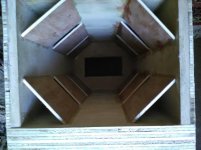
This is the bracing used inside the lower chamber.
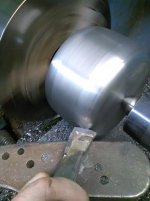
Machining the radius on the cast iron weights the old fashioned way.
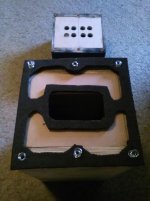
This is the current foam and springs arrangement isolating the two chambers.
I've used them with the weighs in place; I thought that having a mass to push ( or pull ) against would give the drivers a more punchy bass and better transients, however I was wrong, I can hardly tell any difference ( I guess there's not much difference between an magnet many times the weight of the cone and a magnet and weight a bit more than many times the weight of the cone ), however it does seem to have made a remarkable improvement to clarity. I also thought that they'd need a contour network to flatten the frequency response and a fill in tweeter as well, however they sound fine as they are. I never thought that a single 6" driver could sound so clear an detailed, I've heard stuff on familiar CDs that I've never heard before, also percussion is very well resolved, I'm hearing several " taps " when before there was one. The sound stage seems pretty rubbish though.
Last edited:
I removed the tweeter ( not as easy as I had envisioned, a stainless disc on the magnet was glued on, which covered the bolt that held the tweeter in place ), and used the mounting hole through the magnet for a bolt to hold the cast iron weight on. I had originally intended to reuse the tweeter, rear facing and out of phase; however the speakers seem better without it. On previous speakers I have used coaxial car drivers, with the tweeter removed and a stud going through the hole to clamp two drivers back to back to cancel out the reaction forces.
- Home
- Loudspeakers
- Full Range
- A cheap omni ( aperiodic/weight on magnet )
